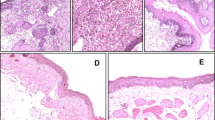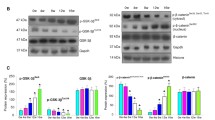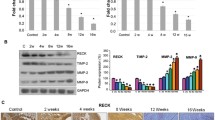Summary
Limonoids from the neem tree (Azadirachta indica) have attracted considerable research attention for their cytotoxicity against human cancer cell lines. However, the antiproliferative and apoptosis inducing effects of neem limonoids have not been tested in animal tumour models. The present study was therefore designed to evaluate the relative chemopreventive potential of the neem limonoids azadirachtin and nimbolide in the hamster buccal pouch (HBP) carcinogenesis model by analyzing the expression of proliferating cell nuclear antigen (PCNA), p21waf1, cyclin D1, glutathione S-transferase pi (GST-P), NF-κB, inhibitor of κB (IκB), p53, Fas, Bcl-2, Bax, Bid, Apaf-1, cytochrome C, survivin, caspases-3, −6, −8 and −9, and poly(ADP-ribose) polymerase (PARP) by RT-PCR, immunohistochemical, and Western blot analyses. The results provide compelling evidence that azadirachtin and nimbolide mediate their antiproliferative effects by downregulating proteins involved in cell cycle progression and transduce apoptosis by both the intrinsic and extrinsic pathways. On a comparative basis, nimbolide was found to be a more potent antiproliferative and apoptosis inducing agent and offers promise as a candidate agent in multitargeted prevention and treatment of cancer.





Similar content being viewed by others
References
Khan N, Afaq F, Mukhtar H (2008) Cancer chemoprevention through dietary antioxidants: progress and promise. Antioxid Redox Signal 10:475–510. doi:10.1089/ars.2007.1740
Sarkar FH (2007) LI YW: Targeting multiple signal pathways by chemopreventive agents for cancer prevention and therapy. Acta Pharmacol Sin 28:1305–1315. doi:10.1111/j.1745-7254.2007.00689.x
Manson MM (2005) Inhibition of survival signaling by dietary polyphenols and indole-3-carbinol. Eur J Cancer 41:1842–1853. doi:10.1016/j.ejca.2005.05.008
Visanji JM, Duthie SJ, Pirie L, Thompson DG, Padfield PJ (2004) Dietary isothiocyanates inhibit Caco-2 cell proliferation and induce G2/M phase cell cycle arrest, DNA damage, and G2/M checkpoint activation. J Nutr 134:3121–3126
Karmakar S, Banik NL, Patel SJ, Ray SK (2007) Garlic compounds induced calpain and intrinsic caspase cascade for apoptosis in human malignant neuroblastoma SH-SY5Y cells. Apoptosis 12:671–684. doi:10.1007/s10495-006-0024-x
Setzer WN, Setzer MC (2003) Plant-derived triterpenoids as potential antineoplastic agents. Mini Rev Med Chem 3:540–556. doi:10.2174/1389557033487854
Subapriya R, Nagini S (2005) Medicinal properties of neem leaves: a review. Curr Med Chem Anticancer Agents 5:149–156. doi:10.2174/1568011053174828
Subapriya R, Nagini S (2005) Ethanolic neem leaf extract protects against N-methyl-N’-nitro-N-nitrosoguanidine-induced gastric carcinogenesis in Wistar rats. Asian Pac J Cancer Prev 4:215–223
Subapriya R, Kumaraguruparan R, Nagini S (2006) Expression of PCNA, cytokeratin, Bcl-2 and p53 during chemoprevention of hamster buccal pouch carcinogenesis by ethanolic neem (Azadirachta indica) leaf extract. Clin Biochem 39:1080–1087. doi:10.1016/j.clinbiochem.2006.06.013
Manikandan P, Vidjaya Letchoumy P, Gopalakrishnan M, Nagini S (2008) Evaluation of Azadirachta indica leaf fractions for in vitro antioxidant potential and in vivo modulation of biomarkers of chemoprevention in the hamster buccal pouch carcinogenesis model. Food Chem Toxicol 46:2332–2343. doi:10.1016/j.fct.2008.03.013
Koul A, Mukherjee N, Gangar SC (2006) Inhibitory effects of Azadirachta indica on DMBA-induced skin carcinogenesis in Balb/c mice. Mol Cell Biochem 283:47–55. doi:10.1007/s11010-006-2269-7
Bose A, Haque E, Baral R (2007) Neem leaf preparation induces apoptosis of tumour cells by releasing cytotoxic cytokines from human peripheral mononuclear cells. Phytother Res 21:914–920. doi:10.1002/ptr.2185
Akudugu J, Gade G, Bohm L (2001) Cytotoxicity of azadirachtin A in human glioblastoma cell lines. Life Sci 68:1153–1160. doi:10.1016/S0024-3205(00)01017-1
Mordue AJ, Blackwell A (1993) Azadirachtin: an update. J Insect Physiol 39:903–924. doi:10.1016/0022-1910(93)90001-8
Cohen E, Quistad GB, Casida JE (1996) Cytotoxicity of nimbolide, epoxyazadiradione and other limonoids from neem insecticide. Life Sci 58:1075–1081. doi:10.1016/0024-3205(96)00061-6
Roy MK, Kobori M, Takenaka M, Nakahara K, Shinmoto H, Isobe S, Tsushida T (2007) Antiproliferative effect on human cancer cell lines after treatment with nimbolide extracted from an edible part of the neem tree (Azadirachta indica). Phytother Res 21:245–250. doi:10.1002/ptr.2058
Harish Kumar G, Chandra Mohan KVP, Jagannadha Rao A, Nagini S (2009) Nimbolide a limonoid from Azadirachta indica inhibits proliferation and induces apoptosis of human choriocarcinoma (BeWo) cells. Invest New Drugs 27:236–252. doi:10.1007/s10637-008-9170-z
Vidya Priyadarsini R, Manikandan P, Harish Kumar G, Nagini S (2009) The neem limonoids azadirachtin and nimbolide inhibit hamster cheek pouch carcinogenesis by modulating xenobiotic-metabolizing enzymes, DNA damage, antioxidants, invasion, and angiogenesis. Free Radic Res 43:492–504. doi:10.1080/10715760902870637
Shklar G (1999) Development of experimental oral carcinogenesis and its impact on current oral cancer research. J Dent Res 78:1768–1772. doi:10.1177/00220345990780120101
Fodstad O, Breistol K, Pettit GR, Shoemaker RH (1996) Boyd Mr: comparative antitumour activities of halichondrins and vinblastine against human tumor xenografts. J Exp Ther Oncol 1:119–125
Bradford MM (1976) A rapid and sensitive method for the quantitation of microgram quantities of protein utilizing the principle of protein-dye binding. Anal Biochem 72:248–254. doi:10.1016/0003-2697(76)90527-3
Legrand-Poels S, Schoonbrodt S, Piette J (2000) Regulation of interleukin-6 gene expression by pro-inflammatory cytokines in a colon cancer cell line. Biochem J 349:765–773
Nagini S, Vidjaya Letchoumy P, Thangavelu A, Ramachandran CR (2009) Of humans and hamsters: A comparative evaluation of carcinogen activation, DNA damage, cell proliferation, apoptosis, invasion, and angiogenesis in oral cancer patients and hamster buccal pouch carcinomas. Oral Oncol (in press).
Kumar S, Suresh PK, Vijayababu MR (2006) Anticancer effects of ethanolic neem leaf extract on prostate cancer cell line (PC-3). J Ethnopharmacol 105:246–250. doi:10.1016/j.jep. 2005.11.006
Roy MK, Kobori M, Takenaka M (2006) Inhibition of colon cancer (HT-29) cell proliferation by a triterpenoid isolated from Azadirachta indica is accompanied by cell cycle arrest and upregulation of p21. Planta Med 72:917–923. doi:10.1055/s-2006-946694
Moldovan GL, Pfander B, Jentsch S (2007) PCNA, the maestro of the replication fork. Cell 129:665–679. doi:10.1016/j.cell.2007.05.003
Maga G, Hubscher U (2003) Proliferating cell nuclear antigen (PCNA): a dancer with many partners. J Cell Sci 116:3051–3060. doi:10.1242/jcs.00653
Haupt S, Berger M, Goldberg M (2003) Apoptosis—the p53 network. J Cell Sci 116:4077–4085. doi:10.1242/jcs.00739
Sarkar FH, Li Y (2008) NF-kappaB: a potential target for cancer chemoprevention and therapy. Front Biosci 13:2950–2959. doi:10.2741/2900
Van Waes C (2007) Nuclear factor-kappaB in development, prevention, and therapy of cancer. Clin Cancer Res 13:1076–1082. doi:10.1158/1078-0432.CCR-06-2221
Karin M, Cao Y, Greten FR (2002) NF-kappa B in cancer: from innocent bystander to major culprit. Nat Rev Cancer 2:301–310. doi:10.1038/nrc780
Wang W, Abbruzzese JL, Evans DB (1999) The nuclear factor kappa B RelA transcription factor is constititively activated in human pancreatic adenocarcinoma cells. Clin Cancer Res 5:119–127
Temme A, Rodriguez JA, Hendruschk S, Gunes S, Weigle B, Schakel K, Schmitz M, Bachmann M, Schackert G, Reiber EP (2007) Nuclear localization of survivin renders HeLa tumor cells more sensitive to apoptosis by induction of p53 and Bax. Cancer Lett 250:177–193. doi:10.1016/j.canlet.2006.09.020
Shen Y, White E (2001) p53-dependent apoptosis pathways. Adv Cancer Res 82:55–84. doi:10.1016/S0065-230X(01)82002-9
Di Ilio V, Pasquariello N, van der Esch AS (2006) Cytotoxic and antiproliferative effects induced by a nonterpenoid polar extract of A. indica seeds on 3T6 murine fibroblasts in culture. Mol Cell Biochem 287:69–77. doi:10.1007/s11010-005-9062-x
Sastry BS, Suresh Babu K, Hari Babu T, Chandrasekhar S, Srinivas PV, Saxena AK, Rao JM (2006) Synthesis and biological activity of amide derivatives of nimbolide. Bioorg Med Chem Lett 16:4391–4394. doi:10.1016/j.bmcl.2006.05.105
Schlüter U (1987) Effects of azadirachtin on developing tissues of various insect larvae. In: Schmutterer H, Ascher KRS (eds) Natural pesticides from the neem tree and other tropical plants. Nairobi, Kenya, pp 331–348
Salehzadeh A, Akhkha A, Cushley W (2003) The antimitotic effect of the neem terpenoid azadirachtin on cultured insect cells. Insect Biochem Mol Biol 33:681–689. doi:10.1016/S0965-1748(03)00057-2
Anuradha A, Annadurai RS, Shashidhara LS (2007) Actin cytoskeleton as a putative target of the neem limonoid azadirachtin A. Insect Biochem Mol Biol 37:627–634. doi:10.1016/j.ibmb.2007.03.009
Singh SP, Abraham SK, Kesavan PC (1996) Radioprotection of mice following garlic pretreatment. Br J Cancer 74:102–104
Bhuvaneswari V, Velmurugan B, Nagini S (2004) Dose-dependent effect of tomato paste on 7, 12-dimethylbenz[a]anthracene-induced hamster buccal pouch carcinogenesis. J Exp Clin Cancer Res 23:241–249
Kigodi PG, Blasko G, Thebtaranonth Y (1989) Spectroscopic and biological investigation of nimbolide and 28-deoxonimbolide from Azadirachta indica. J Nat Prod 52:1246–1251. doi:10.1021/np50066a008
Acknowledgements
This work was supported by a grant from the Department of Science and Technology, New Delhi, India.
Author information
Authors and Affiliations
Corresponding author
Rights and permissions
About this article
Cite this article
Harish Kumar, G., Vidya Priyadarsini, R., Vinothini, G. et al. The neem limonoids azadirachtin and nimbolide inhibit cell proliferation and induce apoptosis in an animal model of oral oncogenesis. Invest New Drugs 28, 392–401 (2010). https://doi.org/10.1007/s10637-009-9263-3
Received:
Accepted:
Published:
Issue Date:
DOI: https://doi.org/10.1007/s10637-009-9263-3




